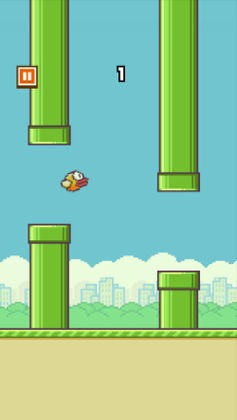I remember when I first learned about Flappy Bird. I was sitting in my dorm room at Purchase doing whatever on my computer, when my roommate called out my name. I turned around and he, knowing I liked games, asked if I had ever heard of Flappy Bird. “No,” I said with some surprise, “what is it?”
“Oh it’s just some dumb game,” he said successfully producing the most useless and flaccid response imaginable. He returned to his game and I went to look it up. To an extent he was correct, it is a video game. More specifically it is a mobile game made with what look like Super Mario World assets (save for the background) where the player needs to dodge pipes by simply tapping the screen.
What I didn’t realize at the time was how big Flappy Bird was going to become (although perhaps I should have since my roommate, who had never really shown an interest in games before, had brought it up out of nowhere). Soon after learning about it, it seemed as if everyone in the gaming world was talking about. It was the latest mobile hit, but no one understood how, and to this day I haven’t heard a satisfying answer.
Flappy Bird has always occupied space in my mind since then. How on Earth did it get so successful? What captures the minds of the mobile market? I’m not sure I have all the answers, but to me the most obvious answer to me lies in the game’s complexity, or lack thereof.

As I mentioned earlier Flappy Bird requires a single input from the player: they just need to tap the screen. The simplicity of the controls means basically anyone can pick up and play it. Player progression is taken care of by the game itself, since it’s an endless runner the player is always moving forward. The difficulty comes from the speed at which player’s character falls after they tap the screen. This turns the entire game into an easy to learn but hard to master series of timing puzzles.
The fact all it takes is a single button press to play makes it extremely easy to pick up and play for long periods of time. Anyone can start playing, get into a rhythm, and just tap away while doing something mindless like waiting on a line. This is on purpose, as the original dev, Dong Nguyen, said he wanted to create something simple compared to Western mobile games, which he considered overly complicated. Other endless runner games thrive off of their simplicity as well, but Flappy Bird simplifies the endless runner gameplay to what I’d argue is perfection. That is to say it is hard to change the core gameplay without it becoming so simple that it’s no longer fun, and it’s hard to add to it without it becoming arduous due to its complexity.

I found myself thinking about Flappy Bird again recently as I tried to come up with my own games to develop for practice. I remembered how simple it was to play, and wanted games that I could similarly design and develop quickly to build up a portfolio. Endless runners seemed particularly enticing because I thought I could use one as a template to make other variations more quickly. I thought a Temple Run clone was more complicated than I wanted to try at the time, and a Rayman Jungle clone would require me to make highly designed levels which is time consuming. Then I remembered Flappy Bird, and thought that I could make something at least as good as it was. But as I sat down and tried to come up with alternatives and variations I realized that I could do little more than copy it. I did come up with something eventually but it wasn’t much fun, and that’s when I began to realize how complete Flappy Bird’s design was.
At the moment I’ve given up trying to prototype one button endless runners and instead am focusing on the basics of UE4 instead. I intend to return to this genre of game, however, and hopefully I can come up with something that I’d proud to say is as good as Flappy Bird.